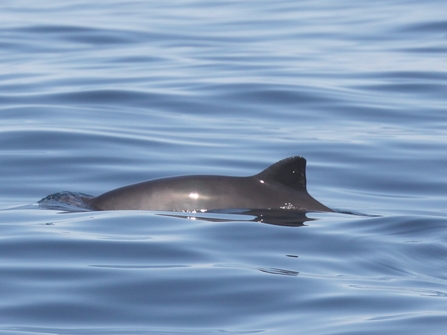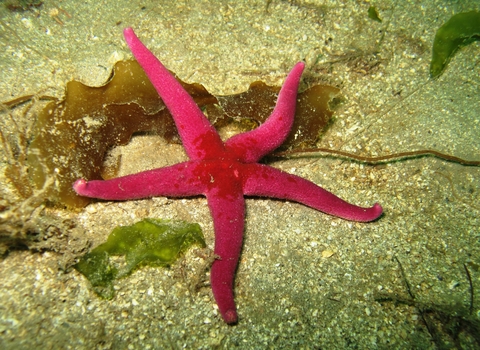Part of nature's recovery
We believe that all development at sea should be environmentally sustainable. It should do as little harm to the environment as possible regardless of what the development is. Development must take place using the right technology in the right place and make a positive contribution to nature’s recovery at sea.
Why is it important?
Our seas need to be managed to recover from past damage, disturbance and neglect. With the demands on our seas for resources and energy, the scale of future development is increasing. Offshore renewables, particularly offshore wind, is a fast-growing industry. Although producing green energy, the construction of offshore wind farms has environmental impacts, including loss and disturbance to habitats and species such as seabirds and marine mammals.
What The Wildlife Trusts are doing
Due to the scale of offshore marine renewable developments, we are engaging closely with this sector. We engage on individual developments and work with government, regulators and statutory nature conservation bodies to influence policy at a national level.

Harbour Porpoise ©Niki Clear
The scale of offshore wind development
Offshore wind farms are not simply ‘onshore wind farms at sea’; they are on a much larger scale. The average size of an onshore wind farm is only 7 turbines, whereas offshore wind farm could have an average of 150-300 turbines. Offshore wind turbine height is projected to reach 300m by 2030, that's approximately the same height as the Shard.
Currently there is around 14GW of offshore wind capacity installed in the UK. Fast forward to 2030 when the ambition is for 50GW to be installed. Finally, to meet net zero by 2050, the ambition is to have at least 75GW of offshore wind installed. This means that in the next 6 years, 35GW of offshore wind farm infrastructure will be installed in our seas. The cumulative impact on the marine environment from this amount of building offshore could be catastrophic if not managed correctly. It is essential that this scale of offshore wind farm development is planned using the right technology in the right location.
Marine planning
Humans use the sea in a variety of ways. From fishing to aggregates, to recreational use we make huge demands on the marine environment. Marine plans aim to set out the sustainable use of our seas. We believe more could be achieved through marine planning. We want to see effective marine spatial planning that strategically prioritises activities and has nature recovery at its heart. Read The Way Back to Living Seas to find out more.
Impact of noise
Our seas are noisy places and underwater noise levels are only set to increase as human industry, development and shipping continue to rise. High levels of underwater noise can cause fatalities, injury (deafness) and disturbance to noise-sensitive animals such as marine mammals and fish, which are known to rely on underwater noise to communicate and feed. The majority of current offshore wind farm technology uses a technique called piling during construction; this is essentially a large hammer that drives the foundations of the turbines into the ground. Given the rising levels of marine activity, we believe underwater noise should be consistently managed for whole seas e.g. the North Sea. We work closely with government and industry to reduce underwater noise impacts and advocate for better underwater noise management.
Impacts on the seabed
Offshore wind farm infrastructure, if located in the wrong place, can cause the loss of seabed habitat. For example, cables to bring the energy produced from offshore wind farms onshore are normally buried below the seabed. However, sometimes this is not possible and consequently cables are covered with rock armour, causing a loss of habitat. As a result, this could cause a loss of important nursery grounds for fish and feeding areas for marine mammals and birds.
Unfortunately we are already seeing negative impacts on seabed habitats from the combined effects of offshore wind farm infrastructure alongside fishing activity, resulting in the decline in the condition of Marine Protected Areas. This is without taking into account the cumulative impacts of future offshore wind farm development to meet the zero by 2050 target. Tools such as marine spatial planning must be used to plan where future activities can take place without damaging the marine environment.
Examples of our work
The Wildlife Trusts secure better management of Dogger Bank SAC
In 2015, we began judicial review proceedings regarding the approval of Dogger Bank Teesside offshore wind farms. This was due to fisheries being left out of the wind impact assessment.
Dogger Bank is a large glacial sandbank situated 62 miles from the English coastline. Formed during the last ice age, it was part of ‘Doggerland’ which connected Britain to mainland Europe. The sandbanks are home to an interesting range of species living both on and in the sand. Although well offshore, this sandbank is home to the fish that feed us and the harbour porpoises, dolphins, whales and seabirds that we enjoy seeing along the east coast.
Unfortunately, Dogger’s sandbanks are currently considered to be at unfavourable condition. The biggest driver of this declining ecological health is fishing. Add to this the impacts of aggregate dredging, oil and gas extraction and now the construction of over 800 wind turbines – and you can understand our concerns.
Following our action, the government gave assurances that management of fisheries would be taken forward for Dogger Bank SAC and that fishing would be included in future offshore wind impact assessments. We were delighted with this outcome. However, we are still seeing the exclusion of fisheries in cumulative impact assessments and we continue to work with government resolve this issue.

